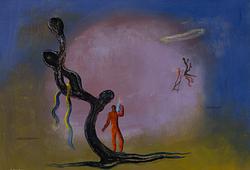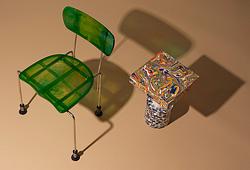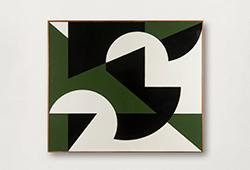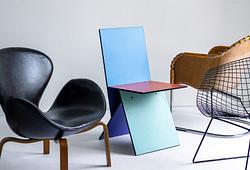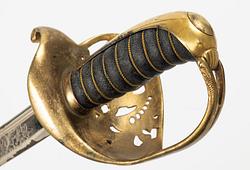Staffan Hallström
"Fyrschack I" (Chess I)
Signed SH. Canvas 116 x 105 cm.
Exhibitions
Riksutställningar, exhibition 106, "Staffan Hallström", 1967, no 37.
Literature
Stig Johansson, "Staffan Hallström", page 105-109.
More information
Staffan Hallström målade schackspel främst för att det var ett så vackert spel. 1964 kom de första schackspelsmålningarna och 1967 visade Konstnärshuset i Stockholm ett urval. Staffan Hallström laborerade i sitt konstnärskap med tillvarons krafter och motkrafter och det rutiga landskapet blev en idealisk scen för det kollektiva konflikttemat som kom ur det individuella som han arbetat med i de många ”familjegrupperingarna” och i verken med ”Salongen”. I schackmotiven kunde pjäserna varieras i det oändliga, nya hot och grupperingar skapades hela tiden. Schack är ett spel som skapar slughet och iskall beräkning, vilket passade Staffan Hallströms utforskande av människans spel på jorden.
Redan som barn fascinerades Staffan Hallström av pjäsernas form och han identifierade dem som soldater i ett krigsspel, precis som i hans lek med tennsoldater. Staffan Hallström kunde spela schack, men någon hängiven fantast blev han aldrig, för honom fanns den intellektuella sidan och möjligheten att skapa konst där vårt livsspel kunde visualiseras. I målningen ”Fyrschack I” har spelet precis börjat, krigarna står färdiga på sina poster, beredda att träda in på livets scen.
Designer
Stephan Hallström supported his painting style with a strong expressive foundation. His paintings arose partly through its materials, but also through his inner psyche. The motifs took shape slowly and rather painstakingly. He revised, sketched anew, and painted over until he finally found a composition and color scheme that had the balance and expression he was seeking. Hallström drew inspiration from Delacroix, Rubens, Goya, and Hill's disease drawings. There is also a trace of Giacometti's drawing of figures and the depiction of intense emotional states.
In Hallströms art the sketching process is very important and his paintings radiate as much line work as painterly poetry. For the artist, revisions were crucial to the final result, and the fact that the creative process is allowed to remain in the finished work makes his paintings still feel very present.
The first version of "Ingens hundar" came in 1953. The artist personifies the dogs which have grouped themselves to protect each other from the greater world. Tall and alert, the dogs raise their gaze to their surroundings and they sniff as much danger as fresh morning air. In this tension of opposites, we find the synthesis of Hallström's painting.
Stig Johansson writes in his book about Staffan Hallström "The ideas and emotional states that drove the creation of "Ingens hundar" made these paintings some of the most original in Swedish art. His motifs and visual concepts remain so unique that they can hardly be compared to anything else."
Read more



